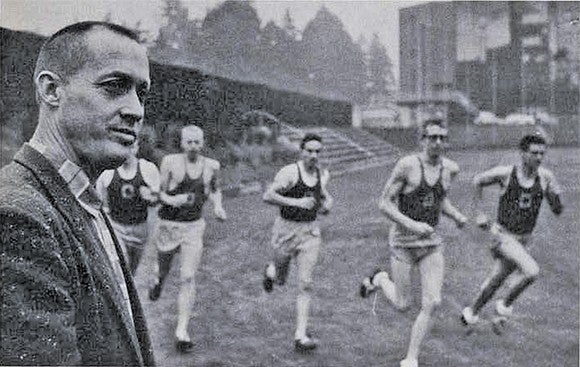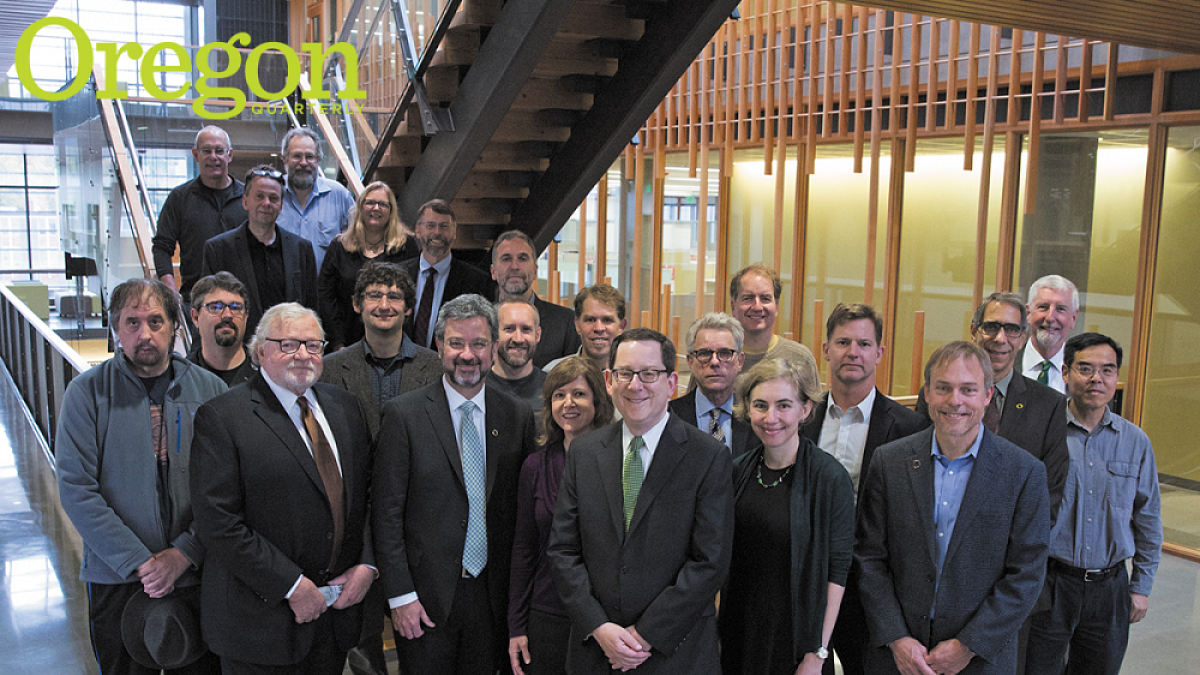What’s now the intersection of Franklin and Agate may soon be known as the intersection of ideas.
That busy corner will be the location of the Phil and Penny Knight Campus for Accelerating Scientific Impact, a $1 billion initiative made possible by a $500 million lead gift and met with a standing ovation when UO President Michael H. Schill revealed the project in October.
Marking an electrifying shift in the future of the university and the state, the Knight Campus will transform the northeast edge of campus with three new state-of-the-art buildings outfitted with cutting-edge labs, research facilities, prototyping tools, imaging facilities, human subject interaction spaces, and an innovation hub.
Designed to thrive on innovation and collaboration, its mission will be to improve human well-being. Its guiding philosophy will be an “impact cycle” of inquiry, insight, innovation, and impact. As results take shape, new fundamental questions arise and the cycle renews.
It will train new generations of scientists, forge tighter ties between the state’s industries and entrepreneurs, and create new educational and career opportunities for graduate and undergraduate students.
The Knight Campus will generate an estimated $80–$100 million of economic activity statewide and, when completed, support 750 to 1,000 jobs, including 30 new top-tier science faculty members and hundreds of staff members and students.

It will enhance and expand collaborations between scientists and faculty members at the UO, Oregon Health & Science University, Oregon State University, Portland State University, and other research institutions around the world.
And it would not be remotely possible if not for the interwoven threads of the University of Oregon’s history of interdisciplinary research and the unmatched generosity of its two most recognized donors.
The Knight name is deeply ingrained in the lore of Oregon, from the storied birth of Nike on the oval of Hayward Field to the proud march of faculty members whose research achievements and teaching excellence have earned them the right to be called Philip H. Knight Professors and Chairs. In academics, the family has contributed significantly to the library, law school, and a faculty endowment. In athletics, Phil Knight led a group of donors who dared the UO to be great, backing the challenge with extraordinary investments in facilities and programs. In business, his company revolutionized an industry, becoming the world’s leading designer, marketer, and distributor of athletic footwear, apparel, and equipment.
The Knight family’s latest contribution invests in the university’s foremost strengths: deep talent in basic scientific research and an extensive history of discoveries stemming from a collaborative, interdisciplinary approach.
“In an age of declining public support for scientific research generally and declining public higher education support specifically, Penny and I are delighted to contribute to these critically important areas,” Phil Knight says.
“While not without risk, we believe the expected societal returns from such investments are high. And here at home in Oregon, we believe the potential to arm our talented young people with the skills and tools they will need to have a lasting impact on the world and to pursue rewarding careers makes such investments essential.”
To some, the Knight’s gift and the scope of the project may have been a surprise. But for those involved in science at the UO, it was an overnight sensation 60 years in the making.
In 1959—the same year Knight graduated from the UO with his business degree—faculty members Aaron Novick, Frank Stahl, and George Streisinger formed the Institute of Molecular Biology. A highly integrated ecosystem where physicists, chemists, and biologists would work together to dissect the molecular underpinnings of living organisms, it spawned a culture of collaboration that influenced fields as far-ranging as neuroscience, the humanities, and social and emotional human development, eventually giving rise to more than 20 UO interdisciplinary research centers and institutes.
More innovations followed. Streisinger pioneered the use of zebrafish as a model organism for studying human disorders, achieving the first-ever large-scale production of genetically uniform clones of a vertebrate organism. The Materials Science Institute and its Graduate Internship Program connected faculty members, students, and research to businesses. Clinical interventions and professional software and database platforms developed in the College of Education attracted increasing amounts of federal research funds.
Over two decades, a strategic emphasis on growing scientific research was successful, supported in part by a business model for “core research” facilities where UO scientists across fields could share access to expensive, cutting-edge equipment. Campus discussions posed the development of a school of applied science, articulating the impact cycle of discovery and innovation that fed back into basic research.
With the 2012 opening of the Robert and Beverly Lewis Integrative Science Building, the Lorry I. Lokey Science Complex was complete, integrating the UO’s life science, chemistry, and physics laboratories into its eight contiguous buildings. Cognitive neuroscientists, psychologists, biochemists, microbiologists, developmental biologists, geneticists, physicists, organic chemists, and physical chemists were now all working in close proximity.
Most recently, a $20 million gift from Connie and Steve Ballmer to hire a faculty team in the area of health promotion and obesity prevention gave traction to the campus-wide initiative for strategic, interdisciplinary hires.
This track record of success was focused into a plan of action on the night of August 4, 2015.
Schill, less than a month into his presidency, invited a group of science faculty members to the McMorran House to talk about UO science and a vision for the future.
“I did know we had a great faculty here, one that was ambitious,” Schill recalls. “I asked them to put their heads together. What could we be if we could be anything in the world? What could we achieve?”
He challenged them to articulate a bold vision that he could take to donors with the capacity to make it happen. He was asking the scientists for their moonshot.
“I heard their dreams and aspirations and what they needed to really make a difference in the world,” Schill says. “I got so excited I started worrying I’d forget it all, so I ran upstairs and started writing it down, and I thought, ‘this is really good. Hopefully in the morning when I wake up it will still be good.’ And it was.”
That pivotal evening helped the new president understand that a cohesive, broad vision of the future-—one that could be achieved with the right resources—was obtainable. And it needed to be about impact.
Over the next four months, two dozen faculty members wrestled with the first question: how to define impact. Did it mean focusing on a specific goal, like curing cancer or diabetes? Did it mean improving the environment? Or did it mean publishing more research, hiring more faculty, and expanding the pipeline for graduate students?
What emerged was a definition not restricted to any one outcome, but rather, an overarching approach guided by a mission to improve societal health and well-being. “Basically the world would become our laboratory,” says Jim Hutchison, the UO’s Lokey-Harrington chair in chemistry. “We’d learn from the world what the most important problems are, and feed those back into our basic research. Discover again, translate into solutions, have impact, inquire again, and then repeat that cycle.”

They envisioned a campus of intellectual fluidity, where, for example, researchers could take an engineer’s view toward solving complex biological problems.
They’d further the concept of core facilities and create wide access to tools such as robots and advanced imaging techniques. Research teams could rapidly screen thousands of compounds for their effects on neural development, then immediately test the most promising of those in a neighboring lab.
One key would be linkage to the UO’s high-performance computing research core facility. “Every physical science, and many social science and arts areas of research, depend heavily upon applied data analytics to uncover patterns that lead to new understanding,” says Joe Sventek, a professor and head of the UO’s computer and information science department. “I see a fruitful collaboration between our data science researchers and the new research teams to develop the applied data analytics they’d need at the Knight Campus.”
The faculty group envisioned new opportunities for the next generations of science students who are thirsting to put their curiosity and creativity to work for the greater good.
And one of the most important impacts would be to create a more diverse community of researchers, says Karen Guillemin, a biologist and director of the UO’s META Center for Systems Biology. “By opening up the kind of science we’re doing, we’re going to be inclusive for people who have different motivations for getting into science,” she says. “That’s going to attract all sorts of new thinkers who are really going to bring different approaches to the table.”
The breathtaking news came that the Knights were ready to commit to a revolutionary $500 million lead investment. On the morning of October 18, before President Schill announced the project to the public, he invited the faculty committee members to breakfast to salute them for their unheralded role in creating the project.
“I needed them to dream, I needed them to teach me, and I needed them to plan,” Schill said. “And they did all three magnificently.”
“This is a mind-blowing gift,” says John Halliwill, who does groundbreaking work in human physiology. “We’re creating a new way to think about science and the university as a way to change lives.”
“This is going to allow us to impact the lives of children, families, individuals,” says Leslie Leve, a lead researcher at the Prevention Science Institute and the College of Education. “It’s amazing.”
At the Phil and Penny Knight Campus for Accelerating Scientific Impact, a new, buzzing intersection where entrepreneurs, marketers, law students, and product designers are embedded among scientists, postdoctorals, and their support teams, the most significant product could be the mountain of new ideas.
“The people capital, that’s going to be one of the biggest legacies of this gift,” Guillemin says.
“Collaboration and innovation,” affirms Bill Cresko, a biologist and associate vice president for research. “It’s in our blood.”
—By George Evano, University Communications
For all time to come, Penny and Phil Knight’s visionary philanthropy, motivated by a fierce loyalty to their home state, will continue to enrich the lives of every UO student while benefitting their fellow Oregonians and contributing to the greater good. Their donations include:
Phil and Penny Knight Campus for Accelerating Scientific Impact
The single largest gift to the University of Oregon
Intercollegiate Athletics
Contributing to the expansion of Autzen Stadium and the construction of the Ed Moshofsky Sports Center; support for the UO track program; the Hatfield-Dowlin Complex; the John E. Jaqua Academic Center for Student Athletes; the Marcus Mariota Sports Performance Center; and the University of Oregon Athletic Department Legacy Fund
Knight Professorships and Chairs
Creation of more than 30 endowed chairs and professorships across campus
William H. Knight Law Center
Lead gift for construction of the law school
Knight Library
Significant family gift toward expansion and renovation of the UO’s main library
Additional Support
The Miller Theater Complex, undergraduate scholarships, faculty and programmatic support


